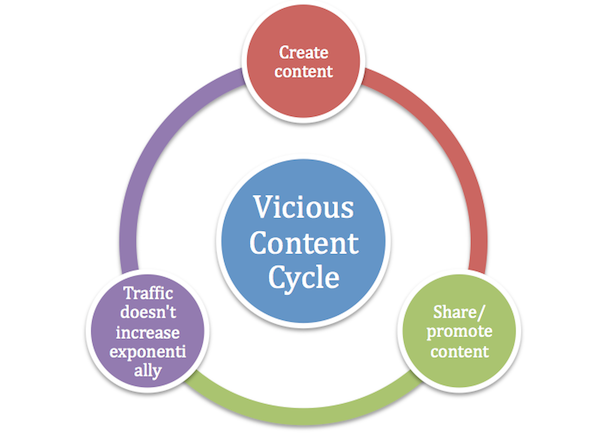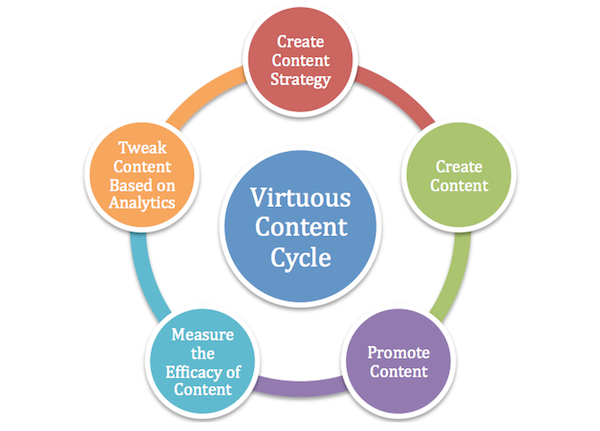Have you heard about the vicious cycle of content creation? Perhaps you’re even in it. It goes something like this:
- You create content.
- You share that content with your network.
- Your content doesn’t become an overnight viral hit.
- You create more content.

Over time, as you keep churning out content, your quality starts to suffer. You aren’t getting the big results you hoped for.
The more you create, the more your quality suffers. So you start producing mediocre content. And that leads to lower traffic and fewer conversions, the exact opposite of what you had hoped to achieve with more content creation.
Eventually you lose momentum and face burnout because it all seems futile. This is the vicious content cycle.
The vicious cycle of content creation is more common than not in the field of content marketing. “Contentitis,” if you will. It’s the obsessive-compulsive need to keep churning out more and more content in the hopes that something will stick.

The negative effects of the vicious content cycle are quite alarming and include:
- Deteriorating quality of content with each successive item published.
- Content that doesn’t flow or build upon central concepts because it’s too haphazardly put together.
- Content that doesn’t get to those who would benefit from it because there’s no time for proper promotion.
- An increasing feeling of being overwhelmed and dismayed over the lack of quick results.
The vicious content cycle (wrongly) assumes that the answer to more traffic is more content. Whereas, more content with the same mindset is what is causing the problems to begin with.
The good news is, we can stop this vicious cycle dead in its tracks. How? Stop creating content. Just simply stop. And go back to the drawing board.
The Virtuous Content Cycle
Here are the three steps you need to implement to turn your vicious content cycle into a virtuous content cycle.
Step 1: Strategize your Content
The simplest way to avoid creating mediocre content on the fly is to have a documented content strategy. Map out the following items in your content strategy:
- A complete buyer profile of the reader you are targeting.
- Keywords you will be focusing on.
- Content topics around your keywords and reader questions.
- An editorial calendar that lays out the frequency and schedule of when your content is published.
- Social networks you’ll use for promotion and why.
- How you will measure results and what will define content success
Step 2: Structure Your Content
Identify the most common types of content you create and create a structure around it. For example, create a list of all the different blog posts you create and convert the structure into a template to follow. Most of Michael Hyatt’s blog posts follow a very similar structure: they contain a personal story or anecdote embedded within each leadership post.
The same concept applies to all forms of content. So if you release a new video blog every week, apply a structure to your videos.
For example, most of Marie Forleo’s “Q&A Tuesday” videos start with a reader’s question, go on to Forleo answering the question in a quirky, memorable way (sometimes with the help of visual aids and props), and end with a call to action for readers to comment, share, and subscribe.
In this way, every piece of content you create follows a set pattern. Establishing a structure that you’re comfortable with helps you develop content faster and helps your audience relate to your content faster. People need to be familiar with your content and style of delivery before they are ready to like you, trust you, or buy from you.
Step 3: Systemize Your Content
Once you have your strategy and your structure down, it’s time to make your content creation process more efficient by cutting out the deadweight. All repetitive tasks need to either be delegated or automated.
That’s why social media automation tools were invented. So every time you create a new piece of content, set up an automation tool to update your social profiles.
When crafting an automated update, make sure that just the scheduled blast is automated, while the content within is written from scratch for each social medium. This will help reduce the robotic effects of non-personal automation. Try IFTTT for creating automation recipes for just about any action!
Important! Once your updates go live, be ready to jump in the conversation in real time.
To maximize your content efficiency, it’s also important to develop systems to in all the different formats that your readers are looking for.
While you’re still in the content creation phase, think about all the different formats and ways your content could reach your audience: via blog post, podcast, infographic, video, SlideShare, and so much more. Aim to convert every piece of content into two or more formats.
When you follow the Strategize-Structure-Systemize process, you are finally on your way to developing a virtuous cycle of content: one that keeps spiraling in an endlessly positive pattern and gives you a progressive return on your content creation.

The five hallmarks of a virtuous content cycle are:
- Create content strategy: When you create your strategy first, you set in motion a clear path to follow.
- Create content aligned with strategy: It becomes easier to create content that falls in with a charted strategy. Moreover, that content now has a clear purpose, making it more valuable.
- Promote content according to pre-determined strategy: Since your strategy charts out the whys and hows of your content promotion, you no longer promote everywhere just because you can. Instead you promote on the channels likely to get you the biggest returns.
- Measure the efficacy of your content: Since you aren’t caught up in the vicious content cycle anymore, you get more time to evaluate the effectiveness of your content and measure it against stated goals set out in your content strategy. That way, you’ll always know if you’re on the right track.
- Tweak content based on analytics and results: The best part of the virtuous content cycle is that it allows you to make adjustments as you execute your content strategy based on what’s working and what’s not.
Summary
If you find yourself creating endless content in a rut with increasingly mediocre quality and dwindling traffic, stop right now and re-assess. Follow the SSS framework (Strategize-Structure-Systemize) to convert your vicious content cycle into a virtuous one.
Let me know in the comments if you have a content strategy and how it helps you!


